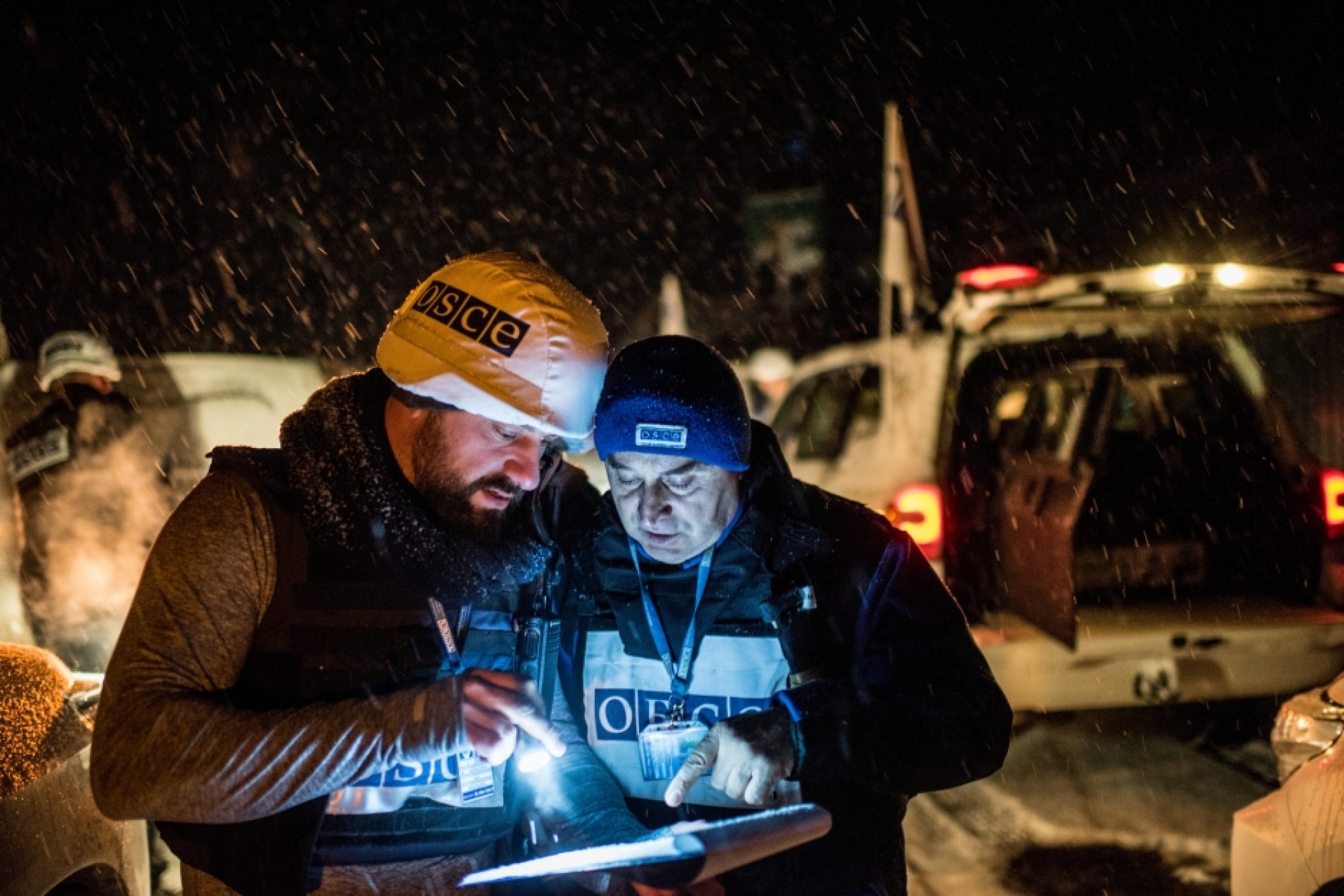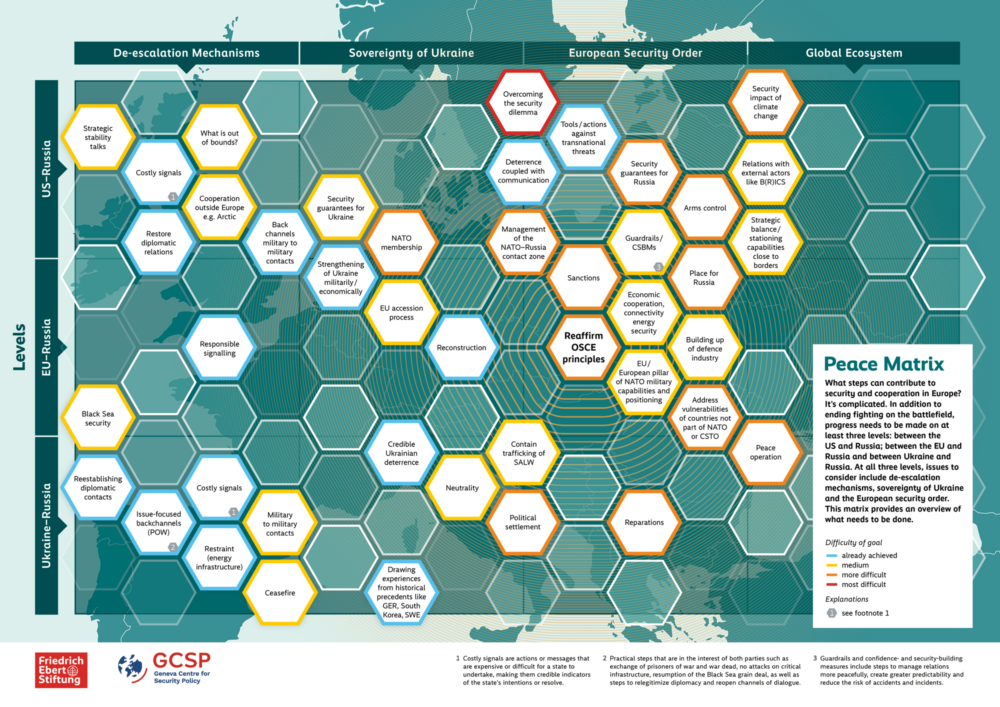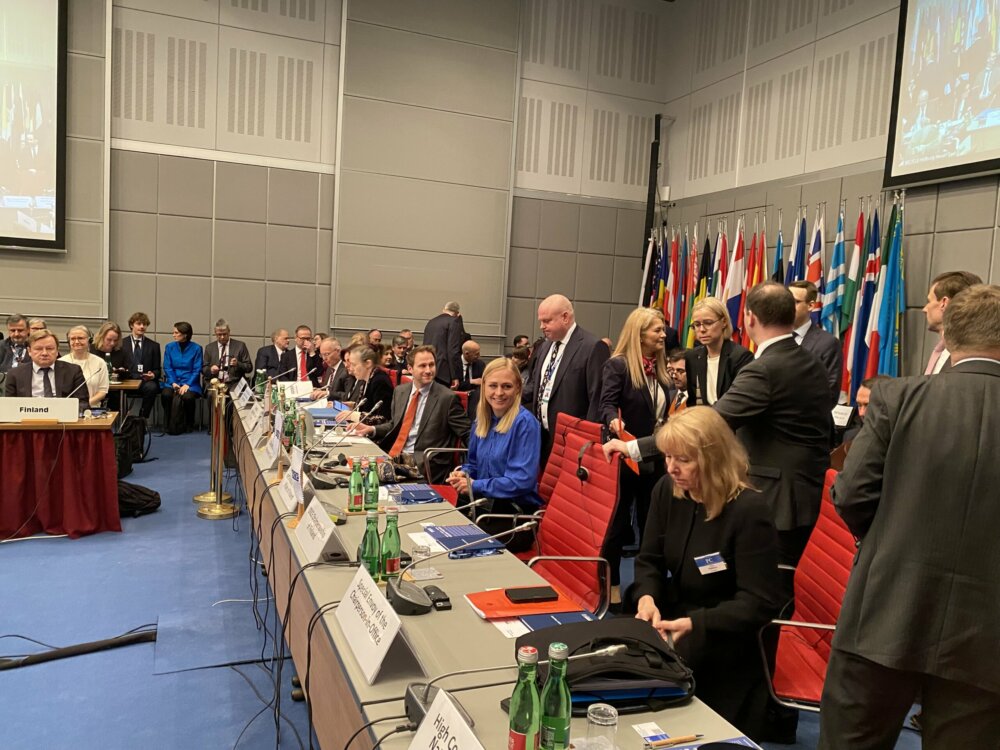Photo: OSCE/Evgeniy Maloletka

“OSCE, keep going!”
The OSCE Special Monitoring Mission (SMM) is the only organization on the ground in eastern Ukraine that provides impartial facts about a confusing conflict that has been going on since 2014. During the past three years, the OSCE SMM has performed essential work in a dangerous conflict environment for which it receives far too little attention and recognition.
The roughly 600 international, unarmed, civilian OSCE monitors go on patrol daily in the Donbass region to monitor the ceasefire that has been agreed upon in the Minsk Agreements.
Last Sunday, such an OSCE patrol ended in a fatal incident. An armoured vehicle by the OSCE SMM hit what was most likely a landmine near the village of Pryshyb, in the area of Luhansk region. As a result, the American paramedic Joseph Stone, who worked for the SMM, died and two other OSCE mission members were injured and taken to the hospital.
According to the OSCE, the road had been used before by the SMM and other civilian traffic, and no mine hazard signs were visible. The laying of mines is in violation of the 19 September 2014 Memorandum, in which all signatories agreed to remove all mines and to allow the Joint Centre for Control and Co-ordination (JCCC) to oversee the mine clearance process. At a press conference in Kiev on 23 April, which was called by the SMM on the occasion of the fatal incident, Alexander Hug, Principal Deputy Chief Monitor of the OSCE SMM, stressed that “it is of utmost importance that the sides take their commitments seriously and remove all mines and explosive devices from Donbass.”
Austrian Foreign Minister and OSCE Chairperson-in-Office Sebastian Kurz and OSCE Secretary General Lamberto Zannier issued a joint statement, extending their condolences to the family of the slain American paramedic. Foreign Minister Kurz also called for a thorough investigation and tweeted: “Those responsible will be held accountable.”
The OSCE SMM is currently conducting an internal assessment of the incident and an investigation is under way.
Whatever the outcome of the investigation, the OSCE SMM should keep going. The work that the Mission has been performing is far too important to be stopped or scaled down. The OSCE SMM deserves full support by all OSCE participating States.
The SMM not only provides impartial facts about ceasefire violations and weapons withdrawal, it also has been engaged in numerous other, largely unrecognized, activities.
For example, in February 2017, OSCE monitors helped to facilitate repair work in order to restore water and heating to Avdiivka, a city in the Donetsk region with a population of roughly 22,000 people. The SMM sent so-called ‘mirror patrols’ to both sides of the contact line to help ensure a cessation of hostilities and to facilitate the repair works.
The OSCE SMM also enabled repairs to the Shchastia power plant north of Luhansk city in April 2016, ensuring the supply of electricity to the civilians. In addition, the Mission facilitated a local ceasefire in January 2016 which allowed for demining and repair work to be done on a water pipeline in Krasnyi Lyman in the Luhansk region. Here, the SMM also sent ‘mirror patrols’ to both sides of the contact line to help ensure the safety of the demining team.
Furthermore, when the fierce battle around the strategic city of Debaltseve came to a temporary halt in February 2015, the SMM monitored the evacuation of civilians from the city.
On several occasions in the last three years, the OSCE SMM also monitored the process of prisoner exchange.
These are just a few examples of the real impact that the work of the civilian OSCE monitors has on the ground in eastern Ukraine.
Besides these activities, OSCE monitors have also established a wide network of contacts in the course of the last three years with all sides to the conflict in eastern Ukraine. The contacts are essential for the Mission to carry out its work. Other international organizations also make use of the SMM’s excellent network in order to perform their own work. For example, in July 2014, OSCE monitors made use of their contacts to rebel leaders and thus escorted international forensic experts to the horrific crash site of Malaysia Airlines flight MH17, located in the middle of the conflict zone in the Donetsk region.
It should also be highlighted that the OSCE SMM enjoys strong political credibility and support. The mandate of the SMM was agreed upon by consensus by all 57 OSCE participating States (including the Russian Federation, Ukraine, the United States and the European Union Member States) in March 2014, after weeks of difficult and lengthy negotiations, led by the then Swiss OSCE Chairmanship. This was considered a great diplomatic success because all relevant parties agreed to the deployment of the Mission at a time of increasing tensions.
However, with the adoption of the two Minsk Agreements in September 2014 and February 2015, the tasks of the SMM were further defined. The SMM was now tasked, besides “fostering peace, stability and security”, to monitor the ceasefire agreed in Minsk, as well as the pull-out of heavy weapons, foreign armed formations and mercenaries from the territory of the Ukraine. These are tasks that are typically carried out by a UN Peacekeeping Mission, usually consisting of armed peacekeepers. Yet, the OSCE monitors are unarmed civilians. In that sense, they are peacekeepers without weapons, as I argued in a previous article.
Some believe that the civilian nature of the OSCE Mission is an asset, making it easier for all parties to accept its deployment and to view it as a neutral actor. Others consider the purely civilian nature of the Mission as inadequate in a dangerous conflict environment.
In fact, according to Mr. Hug, OSCE civilian monitors have been faced with 183 serious security incidents since January 2015, including “shooting at or close to our patrols, shelling or impacts near them, serious physical and verbal threats and damage to our assets, such as our UAVs, cameras and vehicles”, as Mr. Hug explained at a press conference in Kiev on 24 April.
Hence, given the dangerous security situation and the fact that OSCE monitors are actually risking their lives while working for peace in Ukraine, it is understandable that some mitigation measures are now being taken.
However, whatever the outcome of the current investigation will be, it is of utmost importance that the OSCE SMM will not be scaled down. The good news is that a few weeks ago the Mission’s mandate was renewed until March 2018 and its 105.5 million Euro budget was adopted.
The SMM’s important work has to continue. As Mr. Hug stated, “we remain steadfastly committed to fulfilling our mandate and contributing to bringing peace to the people of Ukraine.” OSCE participating States, under the leadership of the Austrian OSCE Chairmanship, should work hard on the political front in order to help achieve that goal.



Comments
* Your email address will not be published